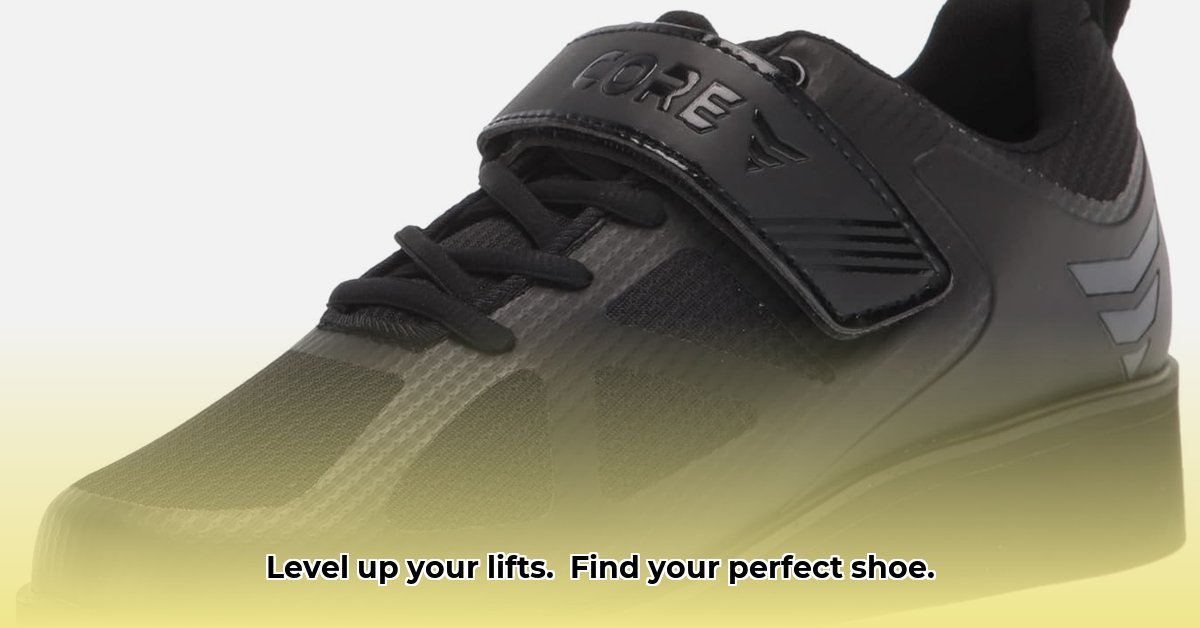Want to lift heavier and feel more confident doing it? Getting the right weightlifting shoes is a game-changer for women. This guide will walk you through everything you need to know to find the perfect pair. No confusing jargon, just plain English and practical tips. We’ll cover heel height, sole materials, fit, and more, ensuring you choose shoes that enhance your performance and help you avoid injuries, so you can focus on crushing your workouts. Let’s find your perfect fit!
Women’s Olympic Lifting Shoes: Your 2025 Guide to Finding the Ideal Pair
Finding the right shoes can make or break your Olympic lifting experience. It’s not just about comfort; the right footwear directly impacts your performance, stability, and injury risk. Let’s explore the critical features and how to choose the perfect pair for you, focusing on factors impacting optimal weight distribution and power transfer.
Understanding the Key Players: Features That Matter for Weightlifting Footwear
Choosing women’s Olympic lifting shoes involves more than picking a visually appealing design. Several key features significantly impact your lifting experience:
Heel Height: The Foundation of Your Lift
Heel height significantly impacts your lifting posture and stability. A raised heel helps maintain a more upright torso during lifts, improving stability and reducing strain on your ankles and knees. The ideal heel height depends on your flexibility, mobility, and lifting style. Generally, weightlifting shoes for women feature a heel height between 0.5 and 1 inch.
- Beginners: A 0.5-0.75 inch heel can provide a stable base without overly restricting ankle mobility.
- Experienced Lifters: Those with good ankle mobility may prefer a 0.75-1 inch heel to further enhance squat depth and upright posture.
Experimentation is key. Start with a moderate heel height and see how it feels. Consider consulting a coach or experienced lifter to determine the optimal heel height for your specific needs.
Midsole: Cushioning and Stability
The midsole, located between the insole and outsole, contributes to cushioning and stability. Common materials include:
- Thermoplastic Polyurethane (TPU): Offers excellent stability and responsiveness, ideal for heavier lifts.
- Ethylene-Vinyl Acetate (EVA): Provides cushioning and shock absorption, suitable for beginners or those who prioritize comfort.
- Wood: Traditional material known for its firm, stable feel and minimal compression.
Outsole: Your Grip on Success
The outsole – the bottom of your shoe – is your connection to the lifting platform. Look for outsoles made from durable rubber with a textured pattern for optimal grip. Common patterns include:
- Herringbone: Provides excellent traction on various surfaces, including wooden platforms and rubber mats.
- Honeycomb: Offers a balance of grip and flexibility.
- Diamond: Delivers multi-directional traction.
Consider your training environment. If you lift on a wooden platform, a herringbone or diamond pattern is an excellent choice. If you train on rubber surfaces, a honeycomb pattern may suffice.
Upper Material: Durability, Comfort, and Breathability
The upper material affects the shoe’s durability, comfort, and breathability. Common options include:
- Leather: Durable and supportive but can be less breathable.
- Synthetic Leather: Offers a balance of durability, support, and breathability.
- Mesh: Lightweight and breathable but may offer less support.
- Canvas: Budget-friendly and flexible but less durable than other options.
Choose an upper material that balances durability, comfort, and breathability based on your training intensity and preferences.
Fit: Like a Second Skin (But for Your Feet)
Fit is paramount. An ill-fitting shoe can lead to discomfort, blisters, and even injury. You want a snug, secure fit without any pinching or excessive tightness. Many manufacturers now offer a wider toe box, giving your toes more room to move naturally and comfortably.
- Width: Ensure the shoe accommodates the width of your foot.
- Length: Allow about a thumb’s width of space between your longest toe and the end of the shoe.
- Security: The shoe should feel secure on your foot, with minimal slippage.
A proper fit allows you to generate power effectively and maintain correct form. A snug fit offers demonstrably better energy transfer compared to loose-fitting footwear.
Closure System: Laces, Straps, and BOA
The closure system secures your foot and provides stability. Common options include:
- Laces: Allow for a customizable fit.
- Straps: Provide additional support and security, particularly across the midfoot.
- BOA: Offers a precise and easily adjustable fit.
Consider your preferences and needs when choosing a closure system. Straps are particularly beneficial for Olympic lifting, where maximum stability is crucial.
Ankle Support: A Balancing Act
Ankle support is another crucial aspect. Some lifters prefer substantial ankle support for added stability, particularly if they have a history of ankle injuries. However, excessive support might restrict movement and feel cumbersome. Others prioritize flexibility for greater freedom of movement. The ideal level of ankle support depends on your individual needs, preferences, and any pre-existing conditions.
Your Step-by-Step Guide to Finding the Perfect Pair, Including Personalized Arch Support
Finding the perfect weightlifting shoe is a journey, not a race. Here’s a detailed step-by-step process to help you navigate the choices:
- Know Your Lifting Style: Are you primarily an Olympic lifter, a powerlifter, or do you incorporate elements of both? Olympic lifting requires greater ankle mobility and heel elevation than powerlifting.
- Assess Your Foot Type: Determine your arch type (high, medium, or low) and foot width. This information will help you choose shoes with appropriate arch support and fit. Consider consulting a podiatrist for a professional assessment.
- Set a Realistic Budget: Weightlifting shoes span a wide price range. Determine your budget upfront to narrow your options and prevent decision fatigue.
- Consider Your Training Frequency: How often do you lift? If you train multiple times per week, invest in a durable pair of shoes that can withstand frequent use.
- Prioritize Your Needs: Rank the importance of heel height, outsole design, material durability, closure type, and ankle support based on your lifting style and personal preferences.
- Research, but Don’t Overthink It: Read reviews, but remember that everyone’s experiences are subjective. Focus on the specific features that are most important to you.
- Try Before You Buy (Whenever Possible): This is the ultimate step. Trying on shoes in a store is the best way to gauge comfort and fit. Wear your usual lifting socks and perform a few squats or lunges to assess the shoe’s performance. If you’re purchasing online, check the retailer’s return policy.
- Break Them In: Weightlifting shoes may require a break-in period. Wear them for shorter periods initially and gradually increase the duration as they become more comfortable.
Navigating the Risks: Potential Pitfalls and How to Avoid Them with Secure Strapping
While weightlifting shoes are designed to enhance your performance, some potential risks need consideration:
| Feature | Potential Risk | Mitigation Strategies |
|---|---|---|
| Elevated Heel | Ankle instability (unlikely with proper technique), Achilles tendon strain | Proper warm-up, gradual weight increases, focusing on perfect lifting form, and stretching the Achilles tendon. |
| Stiff Sole | Reduced foot and ankle flexibility | Incorporate mobility exercises for your feet and ankles, and consider shoes with a slightly more flexible sole. |
| Specialized Outsoles | Reduced grip on non-platform surfaces | Choose outsoles appropriate for your training environment. Carry alternative footwear for non-lifting activities. |
| Material Degradation | Wear and tear over time | Invest in high-quality shoes from reputable brands, and follow the manufacturer’s care instructions. Regularly clean and maintain your shoes. |
| Poor Fit | Blisters, discomfort, and potential injuries | Professional fitting and trying shoes on before you buy them. Ensure adequate width and length. |
| Insufficient Ankle Support | Ankle sprains or instability | Choose shoes with adequate support, or use additional ankle support if needed. Consider ankle sleeves or taping for extra support. |
The Bottom Line: Your Journey to a Custom and Personalized Perfect Fit
Ultimately, the “best” women’s Olympic lifting shoes are the ones that feel right for you. Consider your level of experience, your lifting style, your foot type, and your individual preferences. Take your time, do your research, and don’t hesitate to seek advice from experienced lifters, coaches, or fitness professionals. Remember, investing in the right footwear is an investment in your long-term lifting success and injury prevention. With the right information and a bit of experimentation, you’ll find shoes that empower you to lift heavier, more confidently, and more safely.
- Apps Button on Android Not Working? Fix it Now - November 28, 2025
- Make The Apps Button Work For You On Your Phone - November 27, 2025
- Essential Productivity Apps for Android to Work Smarter - November 26, 2025










